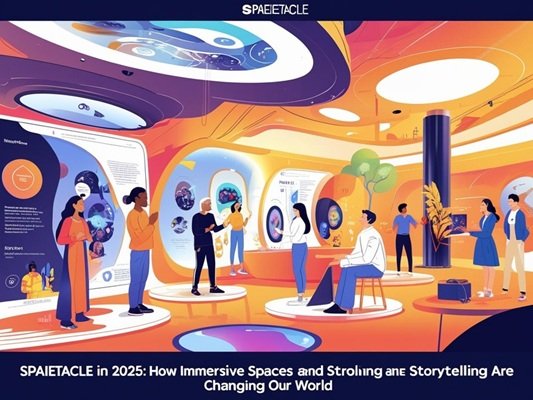In a world where digital fatigue is growing and people are searching for meaningful experiences, a new concept is gaining momentum—Spaietacle. This powerful blend of space and spectacle is transforming how we engage with art, education, entertainment, and culture.
Spaietacle is more than a trend. It represents a major shift in how stories are told and how we, as audiences, interact with them. Instead of watching from afar, people now want to step inside the story—to feel it, live it, and shape it. Spaietacle makes that possible.
What Is Spaietacle? A Simple Definition
The word Spaietacle comes from combining two Latin roots:
- “Spatium” – meaning space
- “Spectaculum” – meaning spectacle or performance
In simple terms, Spaietacle is an immersive experience where space itself becomes the storytelling medium. It’s not about sitting in a theater seat or watching a screen. It’s about walking through a digital art piece, exploring a narrative-filled city square, or interacting with sounds and visuals around you.
Whether through virtual reality (VR), augmented reality (AR), interactive projections, or sensory design, Spaietacle puts the audience at the center of the experience.
Spaietacle vs. Traditional Performances
Let’s compare:
| Feature | Traditional Experience | Spaietacle |
|---|---|---|
| Audience Role | Passive viewer | Active participant |
| Setting | Fixed stage/screen | Physical, digital, or hybrid space |
| Storytelling Style | Linear and scripted | Interactive and multi-layered |
| Use of Technology | Add-on or support | Central to the experience |
| Emotional Impact | Observed from distance | Felt through direct interaction |
This shift from watching to participating is why Spaietacle is being adopted worldwide.
Why Spaietacle Matters Today
The rise of Spaietacle is directly connected to how people live in 2025. After years of digital overload, especially post-pandemic, people want real connection—not just with others, but with spaces, stories, and emotions.
Spaietacle satisfies this need by combining technology, environment, and storytelling in unforgettable ways.
Imagine walking through a city at night where buildings tell their own stories using projection mapping. Or visiting a museum where the exhibit talks to you using AI and reacts to your questions. That’s Spaietacle in action.
How Spaietacle Is Used Today
1. Art and Culture
- Art installations now combine lights, motion, sound, and even scent.
- Public spaces turn into temporary stages for interactive experiences.
2. Education
- Students can “step into” historical moments using AR.
- Biology students explore human anatomy by walking inside 3D models.
3. Architecture and Urban Design
- Buildings are designed to tell stories or change mood using sound and light.
- Parks become story-driven environments that evolve with time of day or weather.
4. Retail and Tourism
- Stores create immersive environments that connect brand and emotion.
- Tourist spots offer digital storytelling via AR headsets or phone apps.
The Technology Behind Spaietacle
Spaietacle doesn’t always need high-tech tools, but when used, they amplify the experience:
| Technology | Purpose | Example |
|---|---|---|
| Augmented Reality | Adds digital content to real spaces | Historical tours via AR glasses |
| Spatial Audio | Moves sound to guide emotions | Museums with voice-activated exhibits |
| Projection Mapping | Transforms physical objects visually | Buildings turned into story walls |
| Haptic Wearables | Let users feel touch or vibration | Virtual empathy simulations |
| Artificial Intelligence | Personalizes stories in real time | AI-guided museum tours |
But here’s the key: Technology fades into the background. The goal isn’t gadgets—it’s immersion.
Spaietacle and Emotional Connection
What makes Spaietacle powerful is how it builds emotion. When users become part of the narrative, the experience stays with them. It’s not about watching a performance. It’s about becoming part of it.
This deepens emotional impact and creates lasting memories. That’s why Spaietacle is being used in everything from therapy to branding.
Challenges of Spaietacle
Despite its promise, Spaietacle must be handled with care:
- Accessibility: Not everyone can engage with tech-driven environments.
- Privacy: Sensors and wearables can track personal data.
- Overload: Too much sensory input can overwhelm users.
- Cultural Sensitivity: Historical or sacred spaces must be treated respectfully.
Responsible design is essential to protect users and communities.
Spaietacle in the Experience Economy
Today’s consumers—especially younger generations—prefer experiences over possessions. This makes Spaietacle a perfect fit for the growing experience economy.
Unlike videos or products, Spaietacle is unique, local, and emotional. You can’t download it. You have to live it.
That’s why brands, educators, and cities are now hiring experience designers, not just marketers or architects.
The Future of Spaietacle
In the years ahead, Spaietacle will become more:
- Personalized: Environments will adapt to user mood and biofeedback.
- Portable: Pop-up experiences for classrooms, therapy, or senior care.
- Ethical: Focused on inclusion, accessibility, and well-being.
- Emotionally Intelligent: Designed to evoke empathy and connection.
It will be less about giant theme parks—and more about intimate, meaningful experiences that change how people feel, think, and connect.
Final Thoughts: Why Spaietacle Matters in 2025
Spaietacle isn’t just a buzzword—it’s a response to modern life. In a time where screens dominate and attention is fragmented, Spaietacle invites us to pause, enter, and feel.
It’s art you walk through, education you explore, and culture you co-create.
As our world grows more digital and disconnected, Spaietacle offers something different: real presence in a virtual age.
Read More: Bunkr Fi F Nheqaf2r5zplr


